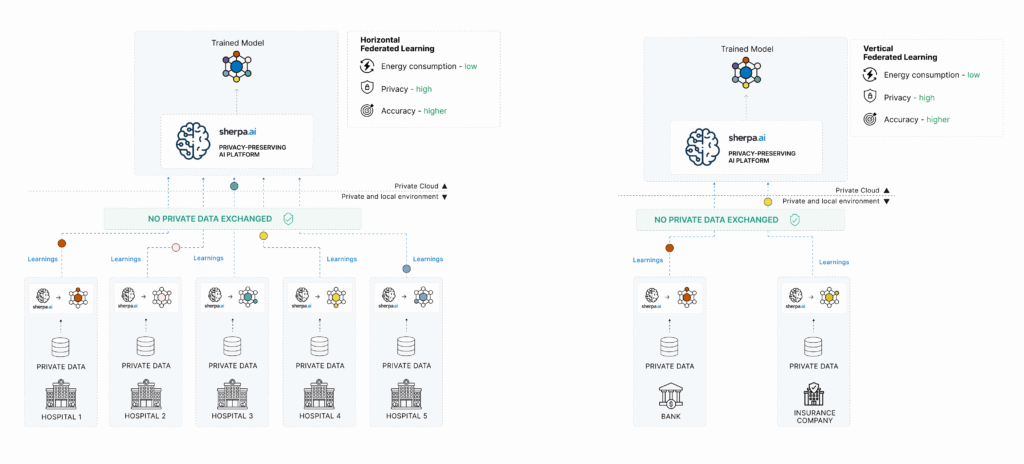
Federated Learning (FL) has emerged as one of the most promising technologies for training artificial intelligence models without the need to centralize data. Thanks to its ability to preserve privacy and comply with regulations like the GDPR, it is increasingly adopted in sectors such as healthcare & Biomedicine, Financial Services, energy, and defense.
But within Federated Learning, there are different technical approaches adapted to the nature of the data and the specific use case.
In this article, we’ve focused on the two most common types of Federated Learning: Horizontal and Vertical, as they form the foundation for most practical applications today. However, there are other paradigms—such as Federated Transfer Learning, Cross-silo FL, or combinations with advanced cryptographic techniques—that address more complex scenarios. These approaches will be covered in greater detail in upcoming blog posts.
Before diving into the differences, let’s briefly review what it is. Federated Learning allows AI models to be trained without moving the data from its original location. Instead of centralizing information on a single server, the model is trained locally at each node (e.g., hospitals or banks), and only model parameters —not the data— are shared with a central server that securely aggregates them.
This approach enables compliance with privacy regulations, reduces the risk of data leaks, and facilitates collaboration between organizations that previously found it legally or competitively impossible.

Horizontal Federated Learning (HFL)
Vertical Federated Learning (VFL)
Horizontal Federated Learning occurs when multiple entities have datasets with the same features but on different individuals.
Example:
Imagine three hospitals in different regions. They all record the same fields for their patients: age, blood pressure, glucose levels, diagnosis, etc. But each has data on different patients. In this case, Horizontal Federated Learning is ideal: each hospital trains the model locally on its own patients, and only the model parameters are shared with a server that aggregates them to improve a global model.
Use cases:
Collaboration among hospitals to improve diagnosis of rare diseases.
Telecom companies building churn prediction models without sharing customer databases.
Recommender systems across subsidiaries of an international group with different users but a shared product catalog.
Which approach is better?
Vertical Federated Learning occurs when different organizations hold information about the same individuals, but with different attributes.
Example:
A bank and an insurance company share many of the same customers. The bank has financial data: income, expenses, credit history. The insurer has health records and insurance policies. Neither entity can share their data directly, but together they could train a much more powerful predictive model. Vertical Federated Learning enables model training by combining this information without either party gaining access to the other’s data.
Use cases:
Credit scoring models between banks and fintech companies.
Fraud detection across financial institutions and telecom operators.
Personalized marketing between companies with complementary customer data.
It depends on the scenario. Both approaches enable model training without compromising privacy, but each is suited to a different situation:
| FL Type | Same set of features | Same set of individuals | Typical Example |
|---|---|---|---|
| Horizontal | ✅ | ❌ | Hospitals with different patients |
| Vertical | ❌ | ✅ | Bank and insurance company with shared clients |
Additionally, there are more complex scenarios, such as Federated Transfer Learning or Cross-silo FL, which combine elements of both or enable knowledge transfer across different domains. However, HFL and VFL remain the foundation for most real-world applications.
Advantages over other privacy-preserving solutions
Although there are other technologies for secure AI training, such as Synthetic Data, Homomorphic Encryption, or Trusted Execution Environments (TEEs), Federated Learning offers a unique combination of benefits:
Privacy by design: data never leaves its original location.
Regulatory compliance: easier to meet GDPR, HIPAA, and other regulations.
Reduced legal and reputational risk: no centralized data storage to be compromised.
Cross-entity collaboration: unlocks value from multiple data sources without sharing the raw data.
Bandwidth and storage efficiency: only model parameters are transferred, not large volumes of raw data.
Bellow you can find a comparison between Federated Learning and other technologies (PETs):
| Feature | Federated Learning | Other Technologies (PETs) |
|---|---|---|
| Privacy | ✅ Very high: data never leaves its source | ✅ High (via encryption, secure environments, or synthetic data) |
| Data sharing | ✅ No data is shared, only model parameters | ❌ Yes, directly or indirectly (synthetic data, encrypted data, secure enclaves) |
| Model accuracy | ✅ High: trained with real data at its origin | ⚠️ Variable: may be affected (especially with synthetic data) |
| Cross-organization collaboration | ✅ Excellent: enables cooperation without sharing sensitive information | ⚠️ Limited: requires agreements or complex technologies |
| Scalability | ✅ High: works from mobile devices to global institutions | ❌ Limited by cost, hardware, or technical complexity |
| Computational cost | ✅ Moderate: local training + secure aggregation | ❌ High (HE/SMPC/TEE) or low with reduced accuracy (synthetic data) |
| Ease of adoption | ✅ High: mature frameworks readily available | ⚠️ Requires expertise in cryptography or data generation/validation |
| Regulatory compliance (GDPR, etc.) | ✅ Very high: privacy-by-design approach | ⚠️ Depends on correct implementation |
Horizontal and Vertical Federated Learning are complementary approaches that allow this technology to be adapted to a wide range of real-world scenarios. Whether in healthcare, finance, energy, or defense, choosing the right FL approach enables the development of more accurate, collaborative, and privacy-respecting AI models.
In a world where data is increasingly valuable —and sensitive—, Federated Learning is not just a technical choice: it’s a strategic necessity.
We have years of experience developing our platform that enable our clients to implement both Horizontal and Vertical FL at scale, securely, and in compliance with regulatory standards. If you are exploring how to integrate this technology into your organization, don’t hesitate to get in touch.